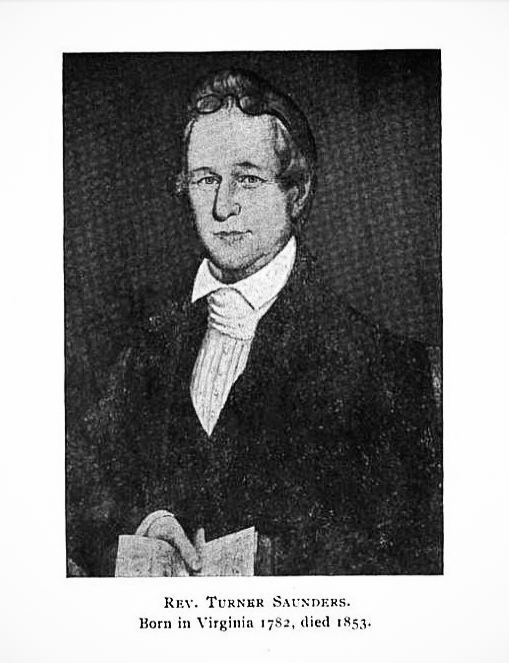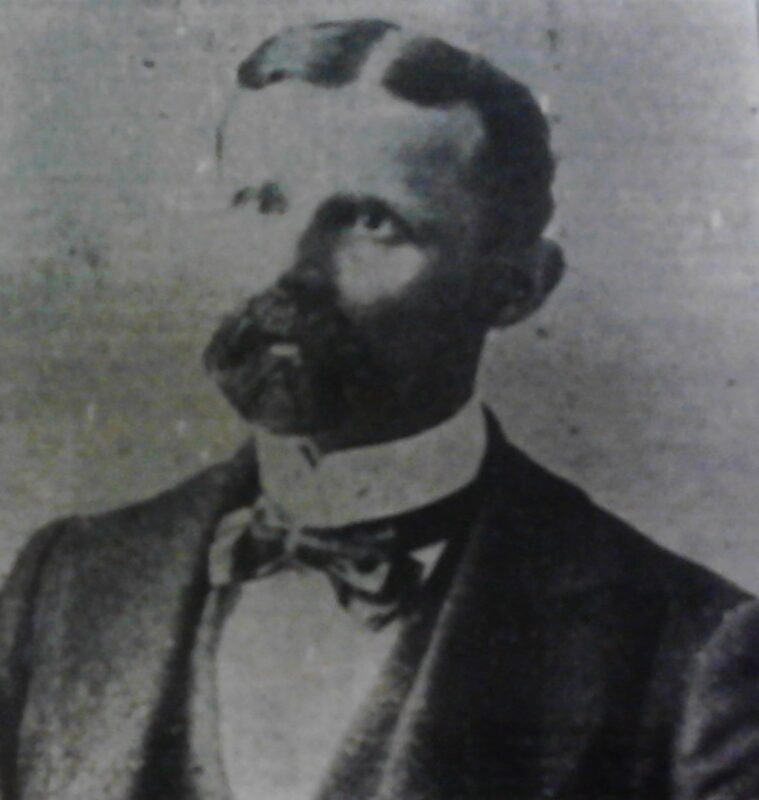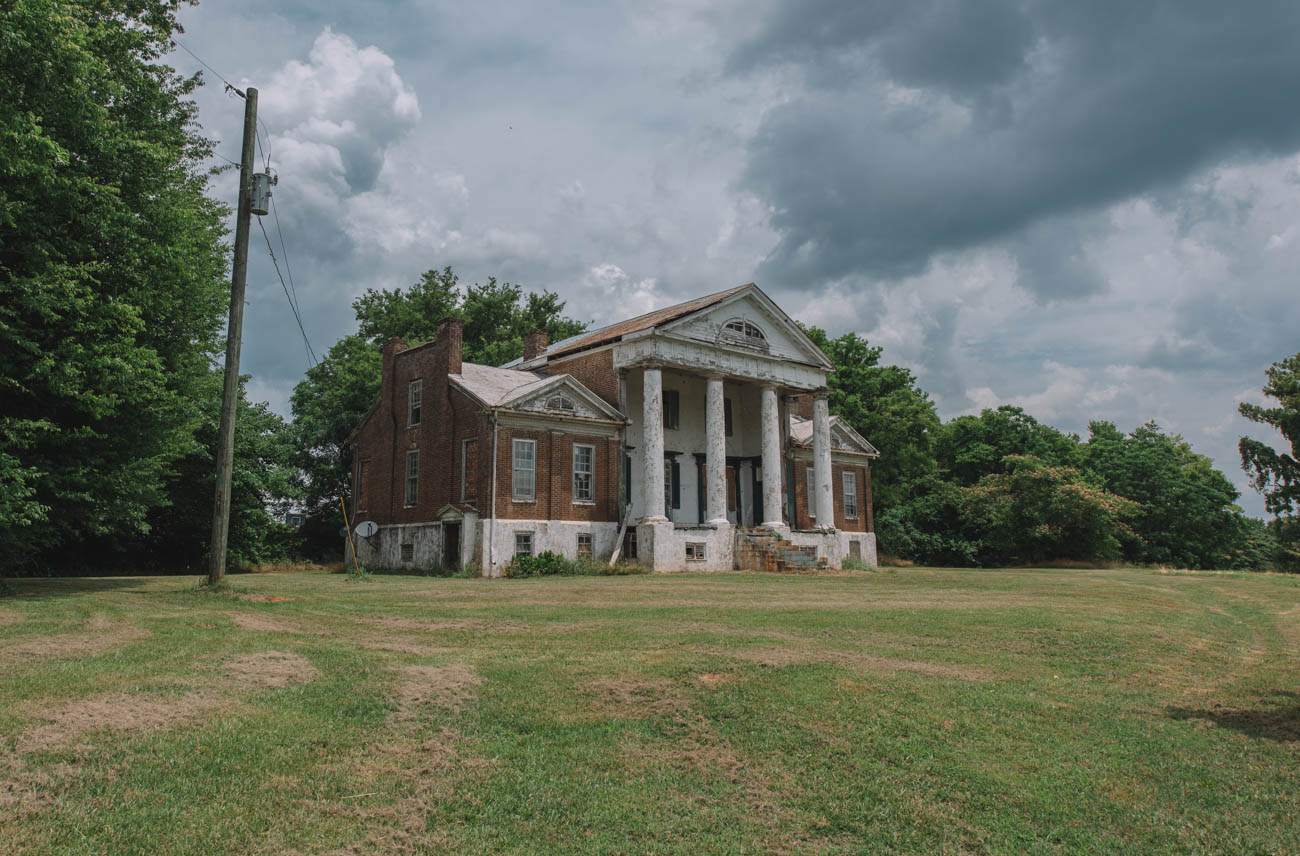| City/Town: • Courtland |
| Location Class: • Residential |
| Built: • 1824 | Abandoned: • N/A |
| Historic Designation: • National Register of Historic Places (1974) |
| Status: • Abandoned |
| Photojournalist: • David Bulit |
Table of Contents
Rev. Turner Saunders
On January 3, 1782, Turner Saunders was born in Brunswick County, Virginia, the son of Revolutionary War veteran Thomas Saunders Sr. and Anne Turner. He was well educated in English studies and sciences and later taught high school classes at the Brunswick County Court House. On July 24, 1799, Turner married Frances Ann Dunn and the two moved to a tract of land located six miles southwest of Franklin, Tennessee in 1808.
They moved into a community of “refined and intelligent” individuals which included Thomas H. Benton, a young attorney from Franklin, who later became a Senator from Missouri; Mrs. Dudley who was a cousin of John Randolph of Roanoke, a planter and prominent politician from Virginia; Colonel Matthias B. Murfree, oldest of Colonel Hardy Murfree, for whom Murfreesboro was named, and father of Dr. James Brickell Murfree, a brilliant physician who later served two terms as mayor of Murfreesboro; Major David Dunn, brother of Frances Ann Dunn Saunders.
This small community was self-sufficient but offered little access to the outside world which proved difficult for the planters there. They grew corn until it fell to ten cents a bushel; they turned on tobacco until it became a drug; then they grew hemp until it could no longer pay for the breaking and hacking of the crop. The residents grew discouraged and moved to various parts of the state including Turner and Francis Ann Saunders who rented out their plantation and moved to nearby Franklin.
In Franklin, Turner Saunders became engaged in the mercantile business, and in a short time, his business quickly expanded, almost monopolizing the trade of furs and pelts of the local Cherokee and Chickasaw Indians. It was here in Franklin that Saunders became involved in the local Methodist church, spreading the word of the gospel among the residents of Williamson County.
Saunders bought land from the Government Land Office in Huntsville in Lawrence County, Alabama in 1820, and in 1822, he and his wife moved to Courtland, Alabama. According to Reverend Richard H. Rivers, Saunders “became a planter on a large scale. He carried the system which made him so successful as a teacher to the plantation. His intelligence was directed to the scientific culture of the soil. He was eminently prosperous, and became the owner of large wealth.“

Death
In Early Settlers of Alabama, Turner Saunders’ son James Edmonds Saunders explains that “In the autumn of 1824 a most virulent fever pervaded the valley of the Tennessee, and a great many people died. Thousands upon thousands of acres of timber had been deadened , and left standing to taint the air with malaria.” That winter, Saunders lost his wife and two sons, Thomas and Franklin.
Saunders married widow Henrietta Weeden Millwater Saunders in 1826 who had two daughters when she married—Sarah and Mary Eliza Millwater. Saunders eventually sold the house and the plantation in 1844 and moved the family to Aberdeen, Mississippi where he died on March 9, 1854. One of his sons, Colonel James Edmonds Saunders, remained in Alabama where he would eventually construct the large Italianate house, Rocky Hill Castle, named so for the brick Gothic tower attached to it which served as the plantation’s slaves’ quarters.
In an obituary by Bishop Robert Paine of the Methodist Episcopal Church, South, and husband of his daughter Mary Eliza, he writes, “Rev. Turner Saunders, our deceased friend, was in the proper sense of the word, a gentleman—a Christian gentleman. Without claiming for him remarkably brilliant intellectual parts, he certainly possessed, in a rare degree, a clear, sound, and a well balanced intellect, a judgment singularly correct, a mind so practical and logical as to be seldom misled by speculations, or puzzled by sophisms, and what is of still higher moment, he had a heart alive to all the interests of humanity.”
“Few men were more extensively or favorably known in our community. His capabilities and business habits were a guarantee of success. Industry, method, neatness, and punctuality were his characteristics. He has left an ample fortune for his family, but the great aim of his life was higher and nobler than the mere acquisition of wealth, and his consistent, pious and useful life is the richest legacy he has left behind him. For about forty years he was a local preacher and was devoted to the doctrines, institutions and usages of the church.”
Saunders Hall
In 1824, Saunders built a large residence located north of the small town of Town Creek. “His home was the abode of elegance, and an enlarged and generous hospitality,” Rivers wrote. “All his surroundings exhibited a taste of exquisite refinement.” It remains one of Alabama’s first large plantation houses and is in relative standing with Belle Mont and Belle Mina as among the oldest large-scale rural mansions in the state.
Architecture
The house is an excellent example of Classic Revival with Late-Georgian trim and detail with influence by the Jeffersonian architecture of Saunders’ native Virginia. The entire house is constructed of brick above a raised basement. The two-story main block features a Tuscan portico with an arched lunette in the pediment and bears a striking resemblance to Thomas Jefferson’s residence, Monticello. The main block is flanked to either side by one-story wings with front and side gables, their front pediments also have lunettes. The front walls of the wings feature brick pilasters with simple capitals. The front door is noteworthy as it features a double-leaf door framed by geometrical sidelights and surmounted by a transom, all set within an engaged architrave or frontispiece composed of fluted Roman Doric columns.
While the architect is unknown, historian Robert Gamble believes it was likely designed by George Steele of Huntsville. Gamble writes, “The same scheme of advanced wings sandwiching a recessed main block occurs in at least two other residences attributed to Steele. Born in 1798 in Bedford County, Virginia, Steele joined the stream of emigration to the lower South as a young man. In time he became one of antebellum Alabama’s foremost builder/architects, even serving on the construction committee for the 1846 statehouse in Montgomery.”


Colonel Freeman Goode
The house was purchased by Colonel Freeman Goode in 1844 who increased the plantation’s acreage to 3,500 acres. He is said to have been a handsome man, a lavish entertainer, and generous to a fault. He was also described as a “wholesouled gentleman, renowned as the dispenser of the most generous and princely hospitality.”
Like so many other southerners, Goode lost his entire estate following the war and went to live with his niece Susan Adelaide Sherrod Shackelford, along with her husband Samuel W. Shackelford. Goode died at their home in Courtland after a “lingering illness of several years,” according to an obituary in The Athens Post.
Saunders Hall Raided
Goode was much too old to serve in the Civil War but his house was always open to Confederates where he entertained many officers who passed through the area. Union troops raided the plantation and burned down the slave quarters. Goode made his way to Decatur, Alabama to see if he could locate any of his slaves that had run away during the raid and found “Uncle Allan” and “Aunt Marthy”.
As reported by Anna Hotchkiss Gillespie in the September 23, 1923 edition of The Birmingham News, Aunt Marthy asked Goode to take care of her belongings as she planned on returning home as soon as she could get away from the “Yankees”. Goode did just that and the couple returned to the plantation where they “stayed on the place in service of their master.” Gillespie goes on to write that “two old darkies“, referencing his servants, served Goode until his death.
In a story published in The Guntersville Democrat in 1903, it’s said that during the war, “a party of two Yankees went out to Mr. Goode’s on a plundering expedition.” Reverend F. S. Petway and his wife were staying at Goode’s house as refugees when the plunderers broke into the house and demanded “money, watches, etc., and were as insolent as freebooters.” Mrs. Petway refused to give them her jewelry and watches which she had tucked in her bosom.
The two men ripped open her dress and took her valuables by force before making off into the woods. After being informed of what had just occurred, the reverend grabbed a shotgun, ran out across the woodland, and shot both men dead. It was said that he had a “tender conscience” and never was himself again after the killings.

Hall Estate
Freeman Goode sold the Saunders house to the Hall family, although there are very few details about who specifically it was sold to. It is reported to have been sold to “the Halls” while other documents such as those found in the National Register of Historic Places and Historical American Buildings Survey state the “Hall estate” purchased it.
The Hall family in question was likely that of John W. Hall but again, the details of Hall’s life are scarce. An obituary written by J. T. Melton states that Hall was born on March 3, 1830, in Lawrence County, Tennessee, although there is conflicting evidence that he was actually born on March 4, 1924. Melton also writes that Hall married Mary E. Scruggs of Lawrence County, Tennessee in 1859 where they resided until his death on May 28, 1880.
According to James Edmonds Saunders though, John W. Hall did marry Mary Elizabeth Scruggs, the daughter of John Wesley Scruggs, and resided in Lawrence County, Alabama where he was buried. John W. Scruggs previously resided in Williamson County, Tennessee near the town of Franklin, and is where Turner Saunders first met Scruggs. His son-in-law John W. Hall was described as one of the county’s “most intelligent and enterprising citizens” and “was a great loss to our community, socially and economically.“
Judge William E. Skeggs
Following Hall’s death, the house was acquired by Celia Ellen Bean Skeggs and rented out the home for many decades afterward. Her husband William E. Skeggs was a probate judge who was educated at Huntsville Academy and came to Decatur in 1871. He was admitted to the bar in 1878 and practiced law at Somerville until 1887 when he opened an office at Decatur. In addition to being a probate judge, he represented Morgan County in the state legislature from 1880 to 1881 and served as a register in the Chancery of Morgan County from 1883 to 1887.
Killing of Officer Thomas E. Wright
On the night of March 26, 1930, Judge Skeggs was stopped by two police officers after allegedly running a stop sign. Officer William P. Moore testified that he approached Skeggs’ vehicle and said “Howdy, Judge. We noticed you run over a stop signal,” to which Skeggs’ replied, “I did not.” Moore then said “I beg your pardon, Judge. But we watched you run over a stop sign as you came out Church Street into Alabama,” to which Skegg’s replied, “I know damn well I didn’t.“
Moore issued Skeggs a citation and told him to be in court at 8 o’clock in the morning to appear in court. Skeggs asked for his name and the officer replied, “Moore. Bill Moore.” Skeggs’ remarked “Yes. You are the damn fellow who has been making all of these arrests.”
Upon hearing this, Officer Thomas E. Wright got out of his vehicle and walked toward Skegg’s vehicle, and said “Judge you shouldn’t talk to us fellows that way—we have our instructions to bring those we arrest to jail or take bond, but we are letting you go on your own word until in the morning.” It was while he was talking that Judge Skeggs pulled out a .41 caliber Derringer and said “take that,” before shooting Wright in the abdomen.
Skeggs testified that when he told Officer Moore that he did not run the stop sign, Moore began to make his way back to the patrol car. In this instance, Wright ripped open Skeggs’ car door and said “Damn it, don’t argue with him, take him out.” The two men grappled in the front driver’s seat and believing these were actually robbers, not police officers, Skeggs picked up his pistol which he had between his legs and fired point-blank at Wright.
Wright drove himself to the police station before being transported to the local hospital where he received several blood transfusions. While in the hospital, Wright recounted the events which led up to the shooting to Officer John T. Bryant. Bryant’s testimony was nearly similar to that of Officer Moore. Wright succumbed to his wounds the following day.
Skeggs was arrested and charged with second-degree murder. After a lengthy trial and multiple witness testimonies, he was convicted and sentenced to ten years in prison. The sentence was appealed and the second trial ended in a hung jury. Before a decision could be made for the second trial, he was struck and killed by an automobile driven by Raymond Stephenson while crossing the street on November 8, 1931.

Decline of Saunders Hall
In 1935, the house was photographed by Alex Bush as part of the Historic American Buildings Survey, and between 2010 and 2012, measured drawings were prepared with the support of the owners, the Alabama Historical, and the North Alabama Chapter of the American Institute of Architects. It was added to the National Register of Historic Places on October 1, 1974, due to its architectural significance.
After Celia Ellen Skeggs’ death in 1928, her son John Hunt Skeggs was made representative of her estate, who in turn sold the house to Leonard Sadler Preuit. The house was later passed down to his son-in-law, Edward Fennel Mauldin.
Mauldin was a partner in Preuit and Mauldin Farms, Gin, and the International Harvester Dealership in Town Creek. He also served on the “National Agriculture Advisory Committee” by President John F. Kennedy and the “National Advisory Committee for Food and Fiber” by President Lyndon B. Johnson. Along with farming, he also was a banker having served as the Chairman and CEO of Bank of Leighton, First Colbert Bank, and First Colbert National Bank. In 1975 he organized The Bank of Florence and merged it with First Colbert National Bank in 1982 to become Bank Independent where he served as Chairman until his death.
The Mauldin family never occupied the old Saunders residence due to its remote location but utilized the 1,000-acre farm property which surrounded the house instead. At one point, repairs were made to the house and rented out. Although the house itself has since fallen into disrepair, the property is still maintained and the farmland surrounding it is still used for its intended purpose.



Photo Gallery
References
Early Settlers of Alabama; James Edmonds Saunders, Elizabeth Saunders Blair Stubbs. (1899)
Historical American Buildings Survey, Library of Congress. (1937). Saunders-Goode-Hall House, State Highway 101, Town Creek, Lawrence County, AL
Society of Architectural Historians; Robert Gamble. (accessed June 7, 2022). Saunders Hall
National Register of Historic Places; W. Warner Floyd. (May 30, 1974). Goode-Hall House
The Birmingham News; Anna Hotchkiss Gillespie. (September 23, 1923). THE FREEMAN GOODE PLACE, Place Owned By Preacher Who Came To Alabama Before It Was State
The Athens Post. (September 17, 1875). Obituary of Col. Freeman Goode
The Moulton Advertiser. (June 17, 1880). Obituary of J. W. Hall
The Decatur Daily. (June 24, 1930). CROSS EXAMINATION OF JUDGE SKEGGS THOUGHT COMPLETE AT RECESS
The Decatur Daily. (October 29, 1931). SKEGGS TRIAL ENDS WITH JURY UNABLE TO REACH A VERDICT; MISTRIAL CASE
The Decatur Daily. (November 10, 1931). FUNERAL SERVICE WEDNESDAY AT 3; Skeggs Service Will Be Held From Home On Johnson Street








































Saunders Hall is actually located just North of Town Creek, AL. Rocky Hill was located in Courtland.
I seemed to have gotten the two mixed up in that regard. Thank you for the correction.